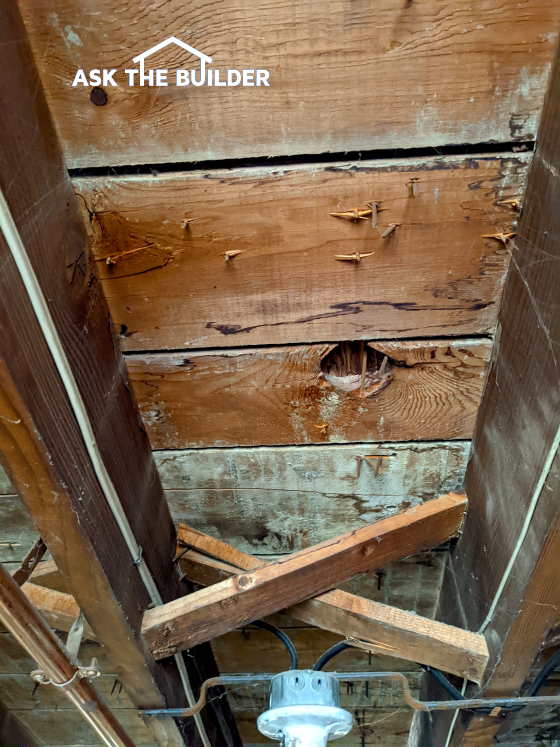Old House Construction

Old House Construction |How could the underside of the original subfloor in this old house be stained by concrete? You’ll be amazed to discover the answer. Copyright 2022 Tim Carter
Old House Construction
Days ago, I was in the basement of an old house with my son. We were looking at the boiler, the structure, and the foundation walls. He’s about to become a first-time owner of a piece of the earth ball. The past four years, he’s been renting a loft apartment and he’s finally realized the breathtaking rent payment he’s been paying each month could be better invested in a home he owns. Truth be told, he’s also been saving so he can make a sizable down payment.
I’ve got three children, and sadly only one of them was old enough to remember me going to the job site each day. In fact, on quite a few Saturdays, I took my oldest daughter with me to job sites to help me do small tasks and to give my wife a well-deserved break. My son and youngest daughter only have memories of me sitting in front of a computer all day because I transitioned from building to writing my syndicated column when they were toddlers or younger. For all I know, they might have thought I was chatting online with babes all day when they saw me staring at my computer monitor.
Because I was unable to immerse my son and youngest daughter into the job site experience, there’s quite a bit they missed out on. I clearly remember explaining very interesting things to my oldest daughter and she always had fantastic questions about things she saw on a construction site.
What is Cross Bracing Between Floor Joists?
My son asked me while we were in the basement, “Dad, what are those diagonal pieces of wood in between the floor joists that make the letter X?” I was impressed he spotted those.
“Oh, that’s a great question. Those are diagonal cross braces that make the floor above much stiffer. Believe it or not, those small 1x3 pieces of wood transfer a concentrated load resting on the floor above to the adjacent floor joists. It’s simple, yet effective, structural engineering. Many people think the primary purpose is to keep joists from twisting. That's not the case. It's exceedingly difficult to have a joist twist when it's secured at one end over the foundation and it's nailed top and bottom where it crosses a beam.”
You’ll find this diagonal bracing on just about every old home, but you rarely find it in new homes. I’m flummoxed why modern code officials have removed this requirement from the model building codes for the most common joist sizes. This isn’t the only great building method that’s been scrubbed from the code. Realize the building code is a set of minimum standards and you can always build something better and stronger than what the code says to do.
Floor, Wall, and Roof Sheathing First Used as Foundation Forms
My son then said, “Dad, is something wrong with the subfloor on top of the floor joists? Is that some sort of fungus or rot? How come the wood is gray and not brown like all the other solid pieces of wood?” He was referring to a few pieces of 1x8s that had concrete cement paste on them.
“Well, you think recycling is a newer concept, think again! Back 100 years ago when this house was built, the carpenters often cast the concrete foundation. They’d use the 3/4-inch-thick lumber that would be used as the house subfloor and the exterior wall and roof sheathing as the wood to build the forms for the foundation. Several days after pouring the concrete, they’d carefully take apart the forms and salvage all of the lumber. They’d then use some of it to create the house subfloor and whatever was left over would be used on the walls and roof.”
Solid-Wood Beams Support Floors
Next up was the main support beam. “Dad, is this solid wood? It’s massive.” He was referring to a timber that measured 7 inches wide, 11 inches high, and 9 feet long.
“Yes, it’s solid wood and look at how few knots are in it. Back when this house was built, it was normal to use wood beams to support the floor joists above. Timber-frame houses and barns are still built today using stunning timbers like this.”
Your takeaway should be that many old houses are very likely built better than what’s being constructed today. But be careful how you define the word better. I’d love to have been around when the carpenters of old saw their first sheets of 3/4-inch CDX plywood that replaced solid 1x6 and 1x8 sheathing. I’d love to have overheard the conversations of old plasterers whose helpers nailed on the thin wood-lath strips when they saw the first sheets of 3/8-inch gypsum plaster lath boards that were 16 inches wide and 48 inches long.
There are countless building products and tools that are used today to build houses faster, but that doesn’t always equate to being better. I’ll readily admit that just about any building product that helps save on energy costs with respect to heating and cooling a house is absolutely better than what was used 100 years ago when energy was so cheap builders didn’t insulate homes.
I can already envision the hundreds of emails I’ll get via the Ask Tim page on my AsktheBuilder.com website. Concrete foundation companies will let me know how they reuse their forms hundreds and hundreds of times. I’ll hear all about the wonderful sub-flooring that resists water damage. No doubt I’ll hear about the plastic-coated wall and roof sheathing and a plethora of other products that are superior to what was available to the builders in the early 1900s. I welcome all of these responses!
Column 1448